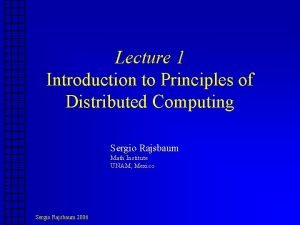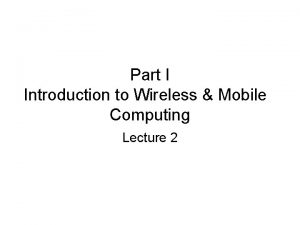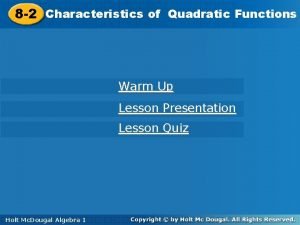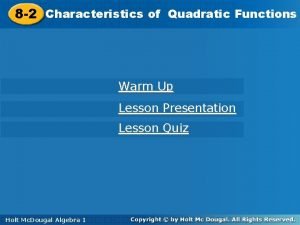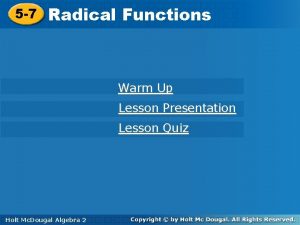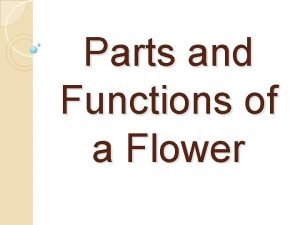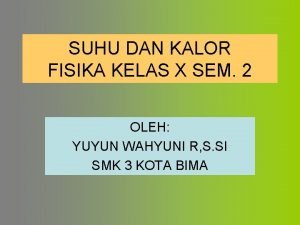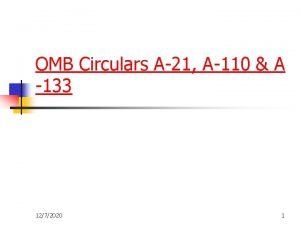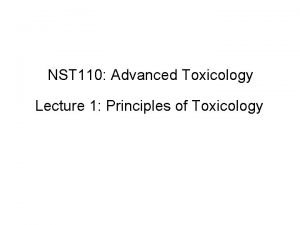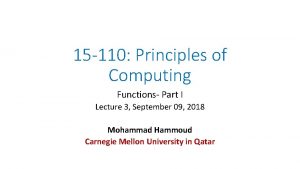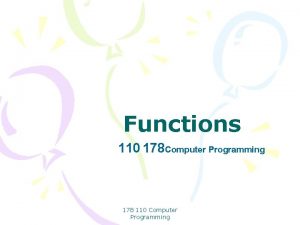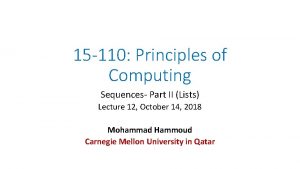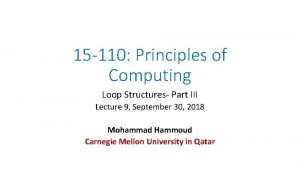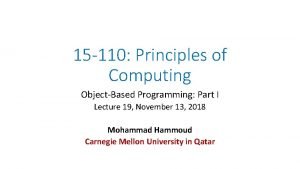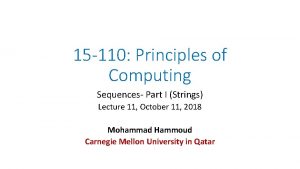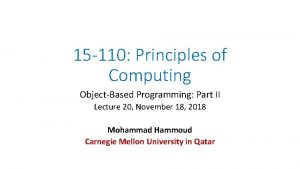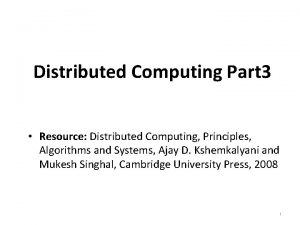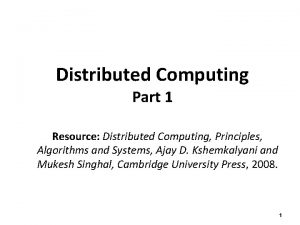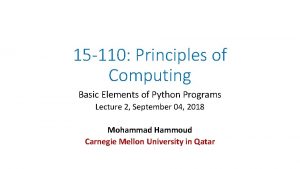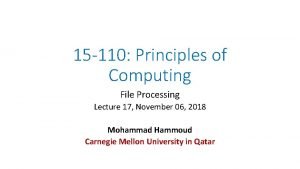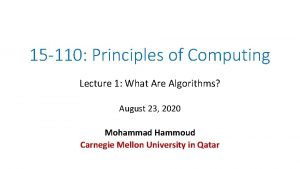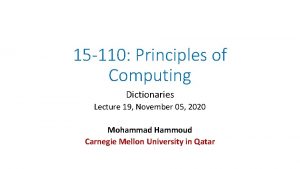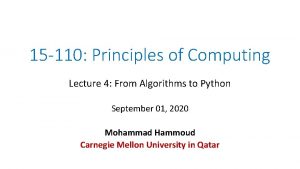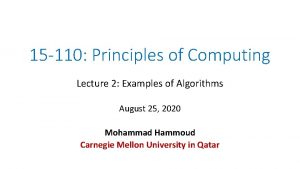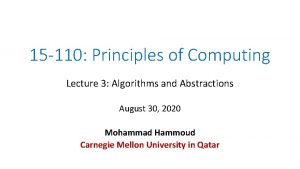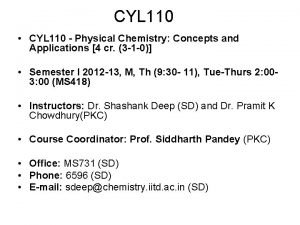15 110 Principles of Computing Functions Part II






















- Slides: 22

15 -110: Principles of Computing Functions- Part II Lecture 4, September 11, 2018 Mohammad Hammoud Carnegie Mellon University in Qatar

Today… • Last Session: • Functions- Part I • Today’s Session: • Functions- Part II: • The software development process • The Python math library • Announcement: • Homework Assignment (HA) 01 is due on Thursday, Sep 13, 2018 by 10: 00 AM

The Software Development Process • Writing programs requires a systematic approach to problem solving, which incorporates 7 major steps 1) Problem analysis, which involves studying deeply the problem at hand 2) Program specification, which involves deciding exactly “what” (NOT “how”) your program will do • What is the input? • What is the output? • What is the relationship between the input and the output? 3) Design, which involves writing an algorithm in pseudocode • This is where the “how” of the program gets worked out

The Software Development Process • Writing programs requires a systematic approach to problem solving, which incorporates 7 major steps 4) Implementation, which involves translating your pseudocode into code (e. g. , using Python) 5) Debugging, which involves finding and fixing errors (or what are often referred to as bugs) in your program • Bugs can be of two types, syntax and semantic (or logical) bugs 6) Testing, which involves trying your program with an extensive set of test cases so as to verify that it works correctly

The Software Development Process • Writing programs requires a systematic approach to problem solving, which incorporates 7 major steps 7) Maintenance, which involves keeping your program up-to-date with technology and the evolving needs of your users • Most programs are never really finished!

Example • Problem: Write a program that translates temperatures from degrees Celsius to Fahrenheit • Solution: 1) Problem Analysis: • Pretty clear; some people do not understand temperatures in Celsius; there is a mathematical formula to convert Celsius to Fahrenheit 2) Program Specification: • Input: temperature in degrees Celsius (say, C) • Output: temperature in degrees Fahrenheit (say, F)

Example • Solution: 2) Program Specification: • Relationship between input and output: • We can do some quick figuring, after which we will realize that 0 Celsius is equal to 32 Fahrenheit and 100 Celsius is equal to 212 Fahrenheit • With this information, we can compute the ratio of Fahrenheit to Celsius; I. e. , (212 – 32)/(100 - 0) = 9/5 • The conversion formula will then have the form F = 9/5 C + k • Plugging in 0 and 32 for C and F, we can immediately see that k = 32 • Thus, the final formula will be F = 9/5 C + 32

Example • Solution: 3) Design: • Pseudocode: Input: C Calculate F as (9/5) * C + 32 Output: F

Example • Solution: 4) Implementation: • Python Code: def main(): celsius = eval(input("What is the Celsius temperature? ")) fahrenheit = 9/5 * celsius + 32 print("The temperature is", fahrenheit, "degrees Fahrenheit") main() Let us run, debug, and test this code together!

Using the Math Library •

Using the Math Library: An Example #The following line will make the math library in Python available for us. import math def roots. QEq(): print("This program finds the real solutions to a quadratic. ") print() a = eval(input("Enter the value of coefficient a: ")) b = eval(input("Enter the value of coefficient b: ")) c = eval(input("Enter the value of coefficient c: "))

Using the Math Library: An Example #To call a function from the math library, we can use the #dot operator as follows: s_root_val = math. sqrt(b*b - 4 * a * c) root 1 = (-b + s_root_val)/(2*a) root 2 = (-b - s_root_val)/(2*a) print("The solutions are: ", root 1, root 2) #Call the function roots. QEq()

Using the Math Library: An Example • One sample run: This program finds the real solutions to a quadratic. Enter the value of coefficient a: 3 Enter the value of coefficient b: 4 Enter the value of coefficient c: -2 The solutions are: 0. 38742588672279316 -1. 7207592200561266

Using the Math Library: An Example • Another sample run: This program finds the real solutions to a quadratic. Enter the value of coefficient a: 1 What is the Enter the value of coefficient b: 2 problem? Enter the value of coefficient c: 3 Traceback (most recent call last): File "/Users/mhhammou/Desktop/CMU-Q/Courses/15110/Programs/Lecture 4/Roots. QE. py", line 22, in <module> roots. QEq() File "/Users/mhhammou/Desktop/CMU-Q/Courses/15110/Programs/Lecture 4/Roots. QE. py", line 14, in roots. QEq s_root_val = math. sqrt(b*b - 4 * a * c) Value. Error: math domain error

Using the Math Library: An Example •

Some Functions in the Math Library Python pi e sqrt(x) Mathematics sin(x) cos(x) tan(x) asin(x) acos(x) atan(x) sin x cos x tan x arcsin x arccos x arctan x e English An approximation of pi An approximation of e The square root of x The sine of x The cosine of x The tangent of x The inverse of sin x The inverse of cos x The inverse of tangent x

Some Functions in the Math Library Python log(x) log 10(x) Mathematics ln x Log 10 x English The natural (base e) logarithm of x The common (base 10) logarithm of x exp(x) ceil(x) floor(x) Ex The exponential of x The smallest whole number >= x The largest whole number <= x

Summary • Programmers use functions to reduce code duplication and structure (or modularize) programs • The basic idea of a function is to write a sequence of statements that together can achieve a certain specification and give that sequence a name • Once a function is defined, it can be called over and over again • Parameters allow functions to receive different input values

Summary • The scope of a variable is the area of the program where it may be referenced • Formal parameters and other variables (which are not labeled as global) inside a function are local to the function (i. e. , can be accessed only within that function) • Local variables are distinct from variables of the same name that may be defined elsewhere in the program

Summary • A function can communicate information back to a caller through returning a value (or multiple values– more on this later) • Python passes parameters by value • Writing programs requires a systematic approach to problem solving, which involves analysis, specification, design, implementation, testing, debugging, and maintenance

Summary • Python programmers can use common mathematical functions defined in the math library • To use any of these functions, you must first import the math library in your program

Next Lecture… • Decision Structures- Part I
 Où se trouve le numéro d'affiliation mutuelle vignette ?
Où se trouve le numéro d'affiliation mutuelle vignette ? 100 011
100 011 Conventional computing and intelligent computing
Conventional computing and intelligent computing Principles of distributed computing
Principles of distributed computing End user computing controls examples
End user computing controls examples Mobile computing function
Mobile computing function Addition symbol
Addition symbol Unit ratio definition
Unit ratio definition Brainpop ratios
Brainpop ratios Technical object description example
Technical object description example Bar prats
Bar prats The phase of the moon you see depends on ______.
The phase of the moon you see depends on ______. Part to part variation
Part to part variation 8-2 characteristics of quadratic functions
8-2 characteristics of quadratic functions Lesson 3-8 transforming polynomial functions
Lesson 3-8 transforming polynomial functions What are the zeros of a quadratic function
What are the zeros of a quadratic function 7 radical din 5
7 radical din 5 Parts of the plant
Parts of the plant Male part flower
Male part flower Troop 110
Troop 110 Silinder logam (t1 = 250°c) dengan diameter 10 cm
Silinder logam (t1 = 250°c) dengan diameter 10 cm Omb a110
Omb a110 Toxicology effects
Toxicology effects



